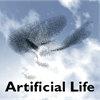基因生命的开放性
IF 1.5
4区 计算机科学
Q4 COMPUTER SCIENCE, ARTIFICIAL INTELLIGENCE
引用次数: 0
摘要
我们在 Genelife 中探索了进化的开放性。Genelife 是康威生命游戏细胞自动机的进化扩展,其中的 "活 "细胞状态在出生时就被赋予了基因组,基因组会影响它们的局部动态,并且可以遗传。对基因序列和局部连接的空间模式进行新颖性分析,跟踪所有新结构,并利用活动统计对创新进行量化。我们还探讨了用非总体规则打破空间对称性和活态增殖的叠加密度调节对进化的开放性的影响。结果发现,遗传和空间模式都呈现出开放式创新。然而,这种创新似乎与功能性生物创新相差甚远,本文讨论了出现这种情况的潜在原因。本文章由计算机程序翻译,如有差异,请以英文原文为准。
Open-Endedness in Genelife
We explore the open-ended nature of evolution in Genelife, an evolutionary extension of Conway’s Game of Life cellular automaton in which “live” cell states are endowed at birth with a genome that affects their local dynamics and can be inherited. Both genetic sequences and locally connected spatial patterns are analyzed for novelty, keeping track of all new structures, and innovation is quantified using activity statistics. The impacts of both spatial symmetry breaking with nontotalistic rules and superimposed density regulation of the live state proliferation on the open-ended nature of the evolution are explored. Conditions are found where both genetic and spatial patterns exhibit open-ended innovation. This innovation appears to fall short of functional biological innovation, however, and potential reasons for this are discussed.
求助全文
通过发布文献求助,成功后即可免费获取论文全文。
去求助
来源期刊

Artificial Life
工程技术-计算机:理论方法
CiteScore
4.70
自引率
7.70%
发文量
38
审稿时长
>12 weeks
期刊介绍:
Artificial Life, launched in the fall of 1993, has become the unifying forum for the exchange of scientific information on the study of artificial systems that exhibit the behavioral characteristics of natural living systems, through the synthesis or simulation using computational (software), robotic (hardware), and/or physicochemical (wetware) means. Each issue features cutting-edge research on artificial life that advances the state-of-the-art of our knowledge about various aspects of living systems such as:
Artificial chemistry and the origins of life
Self-assembly, growth, and development
Self-replication and self-repair
Systems and synthetic biology
Perception, cognition, and behavior
Embodiment and enactivism
Collective behaviors of swarms
Evolutionary and ecological dynamics
Open-endedness and creativity
Social organization and cultural evolution
Societal and technological implications
Philosophy and aesthetics
Applications to biology, medicine, business, education, or entertainment.
 求助内容:
求助内容: 应助结果提醒方式:
应助结果提醒方式:


